
by Laura Tiu | May 3, 2019
There are five species of sea turtles that nest from May through August on Florida beaches, with hatching stretching out until October. The loggerhead, the green turtle, and the leatherback all nest regularly in the Panhandle, with the loggerhead being the most frequent visitor. Two other species, the hawksbill and Kemp’s Ridley nest infrequently. All five species are listed as either threatened or endangered under the Endangered Species Act. Due to their threatened and endangered status, the Fish and Wildlife Conservation Commission/Fish and Wildlife Research Institute monitors sea turtle nesting activity on an annual basis.
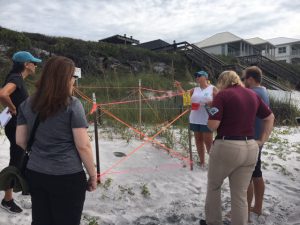
A group checks out a recently hatched sea turtle nest on the dunes in south Walton county in Florida.
Annual total nest counts for loggerhead sea turtles on Florida’s index beaches fluctuate widely and scientists do not yet understand fully what drives these changes. From 2011 to 2018, an average of 106,625 sea turtle nests (all species combined) were recorded annually on these monitored beaches. In 2018, there was a slight decrease in nests with only 96,945 nests recorded statewide. This is not a true reflection of all of the sea turtle nests each year in Florida, as it doesn’t cover every beach, but it gives a good indication of nesting trends and distribution of species.
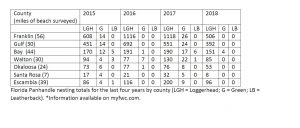
2015-2018 Florida Panhandle turtle nesting totals for all species.
If you want to see a sea turtle in the Florida Panhandle, please visit one of the state-permitted captive sea turtle facilities listed below, admission fees may be charged. Please call the number listed for more information.
- Gulf Specimen Marine Laboratory
222 Clark Dr
Panacea, FL 32346
850-984-5297
Admission Fee
- Gulf World Marine Park
15412 Front Beach Rd
Panama City, FL 32413
850-234-5271
Admission Fee
- Gulfarium Marine Adventure Park
1010 Miracle Strip Parkway SE
Fort Walton Beach, FL 32548
850-243-9046 or 800-247-8575
Admission Fee
- Navarre Beach Sea Turtle Center
8740 Gulf Blvd
Navarre, FL 32566
850-499-6774
The Foundation for The Gator Nation. An Equal Opportunity Institution
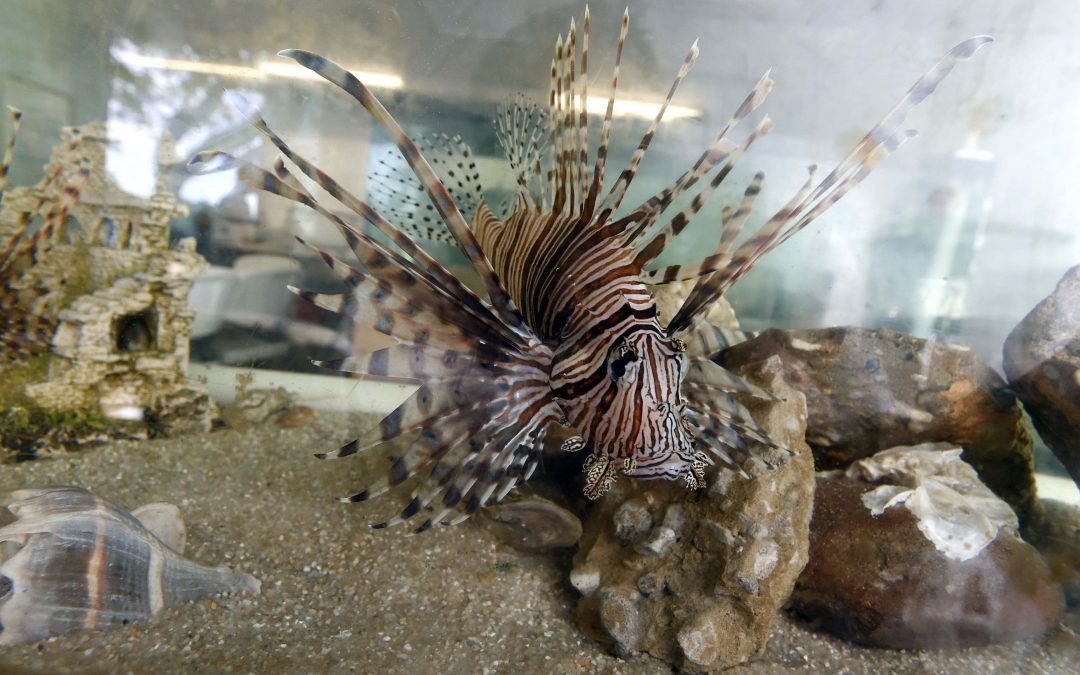
by Laura Tiu | Mar 6, 2019
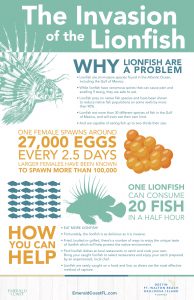
The northwest Florida area has been identified as having the highest concentration of invasive lionfish in the world. Lionfish pose a significant threat to our native wildlife and habitat with spearfishing the primary means of control. Lionfish tournaments are one way to increase harvest of these invaders and help keep populations down.
Located in Destin FL, and hosted by the Gulf Coast Lionfish Tournaments and the Emerald Coast Convention and Visitors Bureau, the Emerald Coast Open (ECO) is projected to be the largest lionfish tournament in history. The ECO, with large cash payouts, more gear and other prizes, and better competition, will attract professional and recreational divers, lionfish hunters and the general public.
You do not need to be on a team, or shoot hundreds of lionfish to win. Get rewarded for doing your part! The task is simple, remove lionfish and win cash and prizes! The pretournament runs from February 1 through May 15 with final weigh-in dockside at AJ’s Seafood and Oyster Bar on Destin Harbor May 16-19. Entry Fee is $75 per participant through April 1, 2019. After April 1, 2019, the entry fee is $100 per participant. You can learn more at the website http://emeraldcoastopen.com/, or follow the Tournament on Facebook.
The Emerald Coast Open will be held in conjunction with FWC’s Lionfish Removal & Awareness Day Festival (LRAD), May 18-19 at AJ’s and HarborWalk Village in Destin. The Festival will be held 10 a.m. to 5 p.m each day. Bring your friends and family for an amazing festival and learn about lionfish, taste lionfish, check out lionfish products! There will be many family-friendly activities including art, diving and marine conservation booths. Learn how to safely fillet a lionfish and try a lionfish dish at a local restaurant. Have fun listening to live music and watching the Tournament weigh-in and awards. Learn why lionfish are such a big problem and what you can do to help! Follow the Festival on Facebook!
“An Equal Opportunity Institution”

by Laura Tiu | Mar 6, 2019
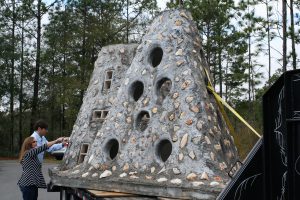
Artificial Reef Pyramid (Photo: L. Tiu)
The Northwest Florida Regional Artificial Reef Workshop was held February 20 at the Emerald Coast Convention Center in Fort Walton Beach Florida. It followed the Northwest Florida Regional Lionfish Workshop held the day before as many in the audience have interest in both lionfish and artificial reefs. Okaloosa County Commissioner, Captain Kelly Windes, gave the welcome, sharing his experiences as a lifelong local and a 3rd generation charter boat captain operating for over 30 years.
Keith Mille, Director of the Florida Fish and Wildlife Commission Artificial Reef Program gave the state updates. In the state of Florida, a total of 3,534 patch reefs have been deployed. In 2018, 187 new patch reefs were added to the mix. These reefs are made from concrete, formed modules, vessels, barges, metal and rock. The Atlantic side received 33 new patch reefs, while the Gulf side deployed 154. Many of the Gulf reefs are funded using Natural Resource Damage Assessment (NRDA) monies intended to compensate anglers and divers for loss of use during the 2010 Deepwater Horizon Oil Spill. According to a recent economic evaluation of artificial reefs by the University of West Florida’s Dr. Bill Huth, fishing and diving on Escambia County’s artificial reefs support 2,348 jobs and account for more than $150 million in economic activity each year.
County updates for Escambia, Santa Rosa, Okaloosa, Walton, Bay, City of Mexico Beach, Franklin, and Wakulla followed with Victor Blanco, Florida Sea Grant Agent from Taylor County, sharing his process for developing and training a volunteer research dive team to monitor the reefs.
University of Florida researchers provided a reef fish communities update highlighting the response of gray trigger fish and red snapper populations near the reefs, as well as the impact of lionfish on these communities. They also provided answers to the question of how artificial reefs function ecologically versus as fishing habitat. This research hopes to enhance future assessments concerning siting and function of artificial reefs. An anthropologist from Florida State University described his role in conducting cultural resource surveys for artificial reefs. The day ended with a report on the assessment of artificial reefs impacted by Hurricane Michael and a demonstration of updated software used to create side scan mosaics for monitoring.
Presentations were recorded and are available on the Florida Artificial Reefs Facebook page. A statewide Artificial Reef Summit is being organized for February 2020 and will be a great opportunity to learn more about Florida reefs.
“An Equal Opportunity Institution”
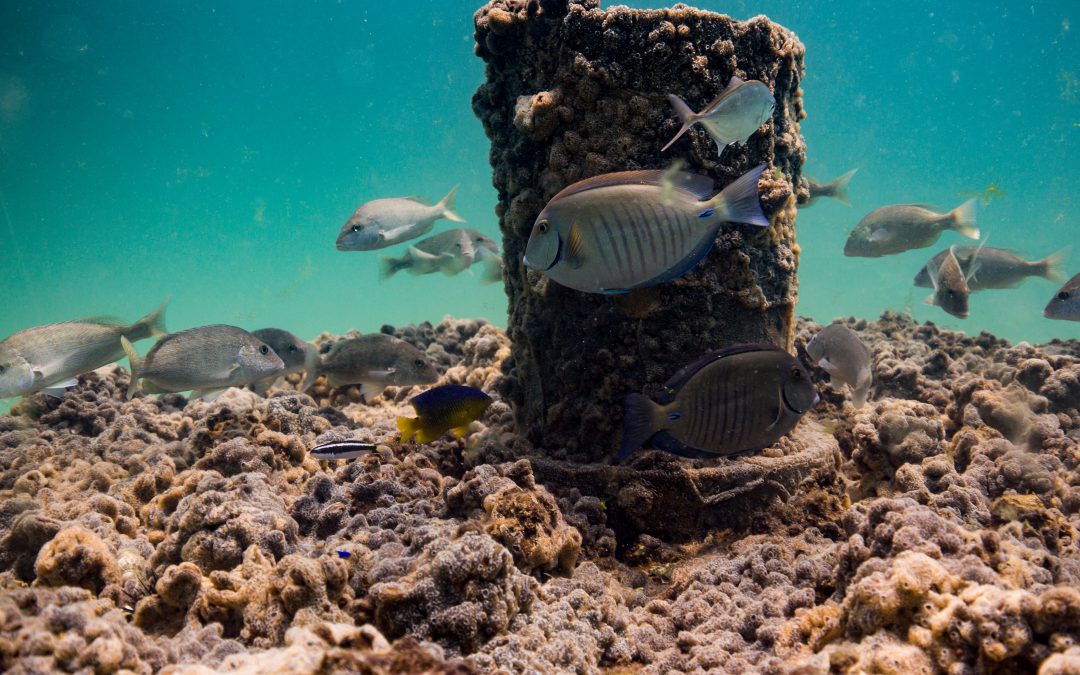
by Laura Tiu | Jan 31, 2019
They say that dreams don’t work unless you take action. In the case of some Walton County Florida dreamers, their actions have transpired into the first Underwater Museum of Art (UMA) installation in the United States. In 2017, the Cultural Arts Alliance of Walton County (CAA) and South Walton Artificial Reef Association (SWARA) partnered to solicit sculpture designs for permanent exhibit in a one-acre patch of sand approximately .7-miles from the shore of Grayton Beach State Park at a depth of 50-60 feet. The Museum gained immediate notoriety and has recently named by TIME Magazine as one of 100 “World’s Greatest Places.” It has also been featured in online and print publications including National Geographic, Lonely Planet, Travel & Leisure, Newsweek, The New York Times, and more.
Seven designs were selected for the initial installation in summer of 2018 including: “Propeller in Motion” by Marek Anthony, “Self Portrait” by Justin Gaffrey, “The Grayt Pineapple” by Rachel Herring, “JYC’s Dream” by Kevin Reilly in collaboration with students from South Walton Montessori School, “SWARA Skull” by Vince Tatum, “Concrete Rope Reef Spheres” by Evelyn Tickle, and “Anamorphous Octopus” by Allison Wickey. Proposals for a second installation in the summer of 2019 are currently being evaluated.
The sculptures themselves are important not only for their artistic value, but also serve as a boon to eco-tourism in the area. While too deep for snorkeling, except perhaps on the clearest of days, the UMA is easily accessible by SCUBA divers. The sculptures are set in concrete and contain no plastics or toxic materials. They are specifically designed to become living reefs, attracting encrusting sea life like corals, sponges and oysters as well large numbers and varieties of fish, turtles and dolphins. This fulfills SWARA’s mission of “creating marine habitat and expanding fishery populations while providing enhanced creative, cultural, economic and educational opportunities for the benefit, education and enjoyment of residents, students and visitors in South Walton.”
The UMA is a diver’s dream and is in close proximity to other Walton County artificial reefs. There are currently four near-shore snorkel reefs available for snorkeling and nine reefs within one mile of the shore in approximately 50-60 feet of water for additional SCUBA opportunities. All reefs are public and free of charge for all visitors with coordinates available on the SWARA website (https://swarareefs.org/). Several SCUBA businesses in the area offer excursions to UMA and the other reefs of Walton County.
For more information, please visit the UMA website at https://umafl.org/ or connect via social media at https://www.facebook.com/umaflorida/.
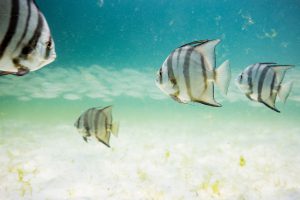
Schools of fish swim by the turtle reef off of Grayton Beach, Florida. Photo credit: University of Florida / Bernard Brzezinski

by Laura Tiu | Nov 26, 2018
Red Tide has been a persistent presence in the Panhandle since September and responsible for many reported fish kills and respiratory distress in some people. Over the past week, red tide was still present in low to medium concentrations in or offshore of Escambia County to Bay County.

Jack-knife fish killed by red tide Miramar Beach, Florida
Red tide is a natural occurrence and Florida experienced red tides long before humans settled here. The tides originate 10-40 miles off shore and winds and currents bring them inshore. Red tide is fueled by nutrient typically stemming from land-based runoff.
During winter, the northerly winds and southbound currents will push the tide back offshore. There was hope that Hurricane Michael might help carry the red tide back out to sea. Unfortunately, it seems the nutrient run-off from the storm’s heavy rain or retreating storm surge may have contributed to the intensity and duration of the bloom.
In our economy, which is heavily dependent on tourism, the red tide is continuing to take a toll, especially on waterfront businesses. According to the Florida Fish and Wildlife Conservation Commission, store-bought and restaurant served shellfish are safe to eat during a red tide bloom because shellfish are monitored for safety and tested for red tide toxins before they are sold. The edible parts of crabs, shrimp and fish are not affected by the red tide organism and can be eaten, but guts should be discarded.
Many remember the local red tide bloom in 2015. The longest red tide bloom ever recorded lasted 30 months from 1994 to 1997. Warmer water due to climate change is predicted to cause algae to bloom more often, more intensely, and in more water bodies. It is imperative that we reduce nutrient inputs to our lakes, rivers, estuaries and coastal ocean waters today.











